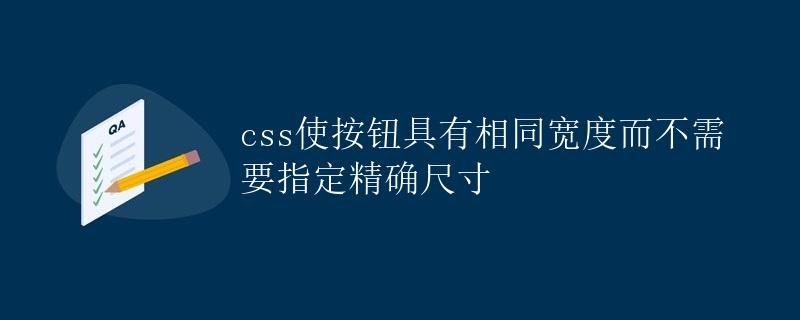CSS to make buttons the same width without specifying exact dimensions
CSS makes buttons the same width without specifying exact dimensions

In web design, you often need to arrange multiple buttons in a row. To maintain a neat and aesthetically pleasing appearance, you typically want these buttons to be the same width. However, if you simply specify the width of each button, the layout will become messy if the text becomes too long or the number of buttons changes. So, is there a way to make buttons the same width without specifying exact dimensions? The answer is yes, we can achieve this using CSS flex layout.
Using Flex Layout to Arrange Buttons with Equal Widths
Flex layout is a new layout mode in CSS3 that allows for simple and flexible arrangement of child elements. By setting display: flex on a parent element, child elements automatically align according to certain rules. Let’s see how to use Flex layout to achieve the effect of arranging buttons with equal widths.
<!DOCTYPE html>
<html lang="en">
<head>
<meta charset="UTF-8">
<meta name="viewport" content="width=device-width, initial-scale=1.0">
<title>Equal Width Buttons</title>
<style>
.button-container {
display: flex;
}
.button {
flex: 1;
padding: 10px;
text-align: center;
background-color: #3498db;
color: #fff;
border: none;
cursor: pointer;
}
</style>
</head>
<body>
<div class="button-container">
<button class="button">Button 1</button>
<button class="button">Button 2</button>
<button class="button">Button 3</button>
</div>
</body>
</html>
In the example code above, we create a parent element, .button-container, and set it to display: flex, so that the child elements will be arranged with equal widths horizontally. Each button .button has the flex: 1 property set, indicating that they occupy an equal amount of space within the parent element, thus achieving the equal-width effect. Additionally, we’ve added some styling to the buttons to make them look more aesthetically pleasing.
Further Optimization
If you want spacing between buttons, you can add an additional container between them. You can also use the justify-content property to control button alignment. Let’s look at some further optimized example code.
<!DOCTYPE html>
<html lang="en">
<head>
<meta charset="UTF-8">
<meta name="viewport" content="width=device-width, initial-scale=1.0">
<title>Equal Width Buttons</title>
<style>
.button-container {
display: flex;
justify-content: space-around;
}
.button-wrapper {
margin: 0 10px;
}
.button {
flex: 1;
padding: 10px;
text-align: center;
background-color: #3498db;
color: #fff;
border: none;
cursor: pointer; }
</style>
</head>
<body>
<div class="button-container">
<div class="button-wrapper">
<button class="button">Button 1</button>
</div>
<div class="button-wrapper">
<button class="button">Button 2</button>
</div>
<div class="button-wrapper">
<button class="button">Button 3</button>
</div>
</div>
</body>
</html>
In this example, we add a .button-wrapper container to provide spacing between each button and set the margin: 0 10px style. We also use justify-content: space-around to ensure the buttons are evenly spaced within the parent container.
Summary
Using Flex layout, we can easily achieve the effect of arranging buttons with equal widths without having to precisely specify the width of each button. This method is not only simple and efficient, but also highly flexible, adapting to changes in button content and quantity.